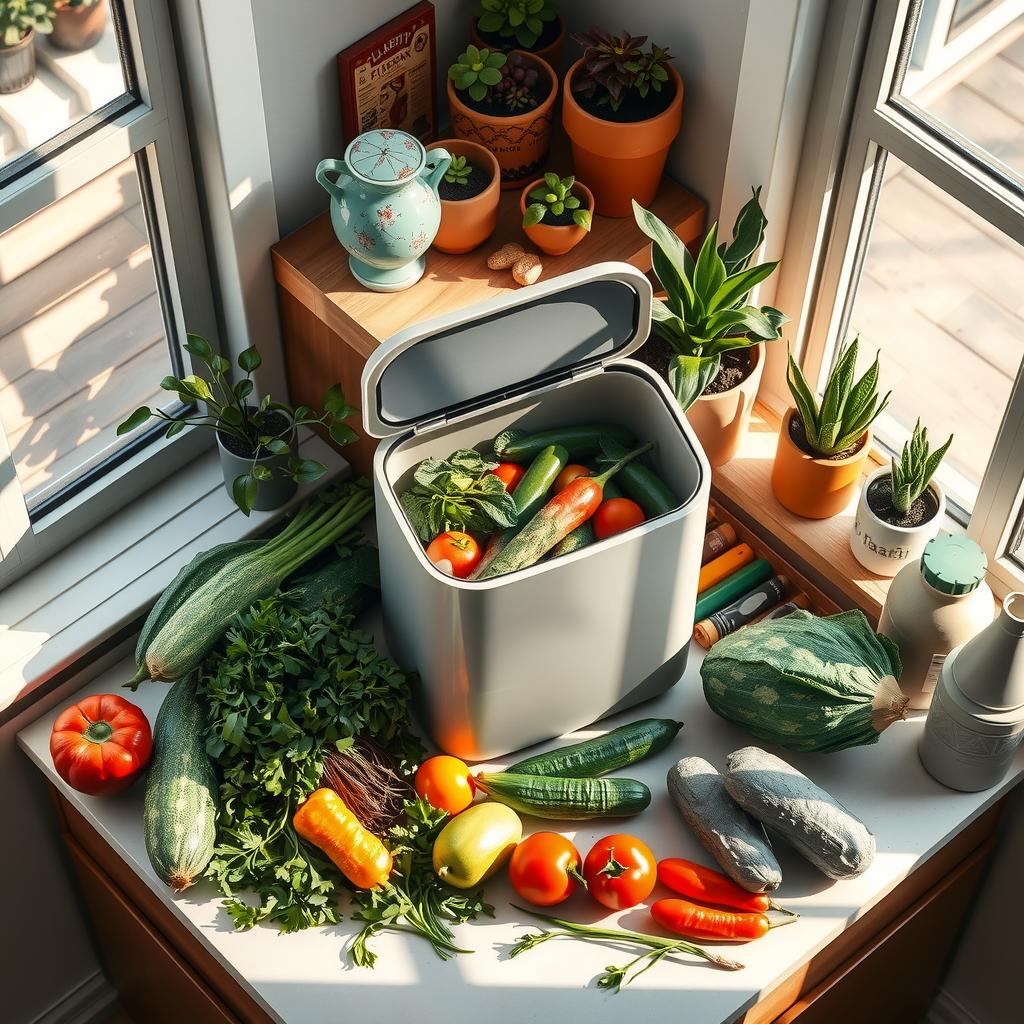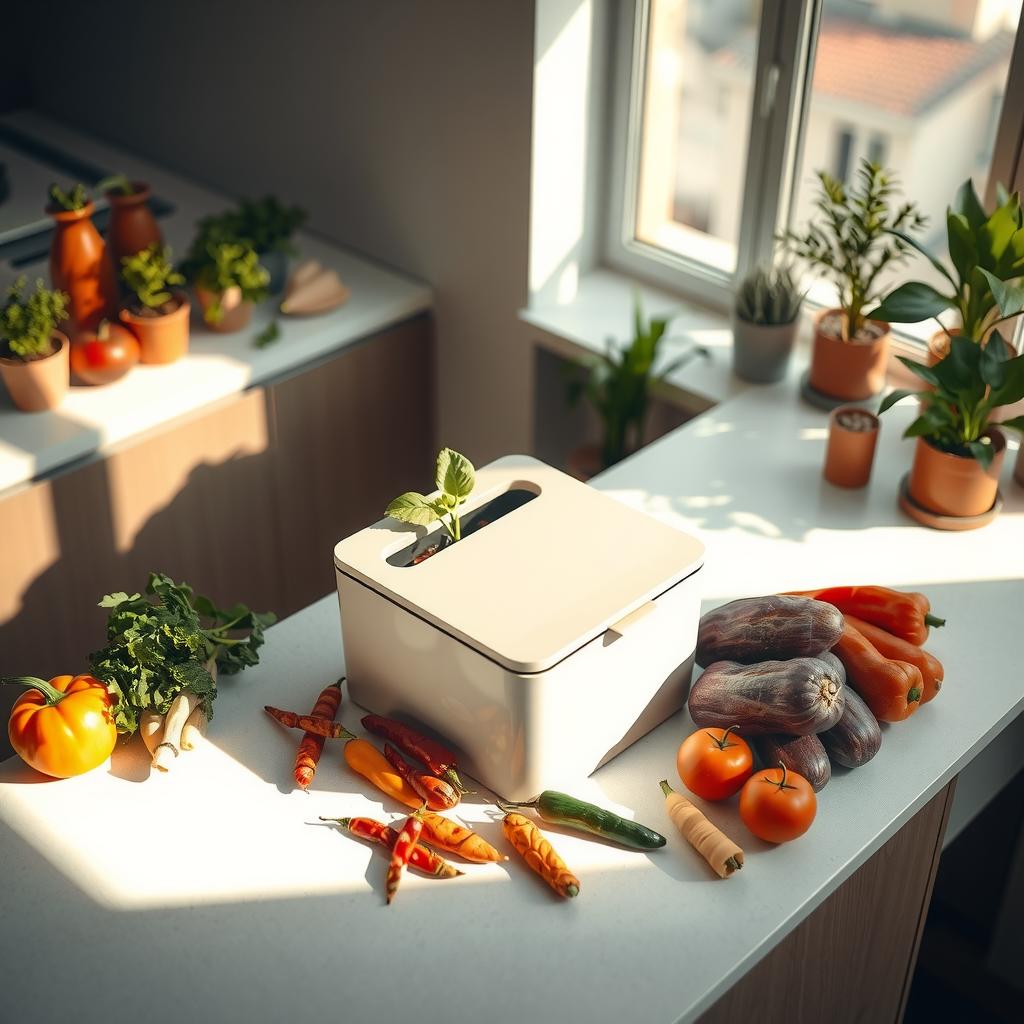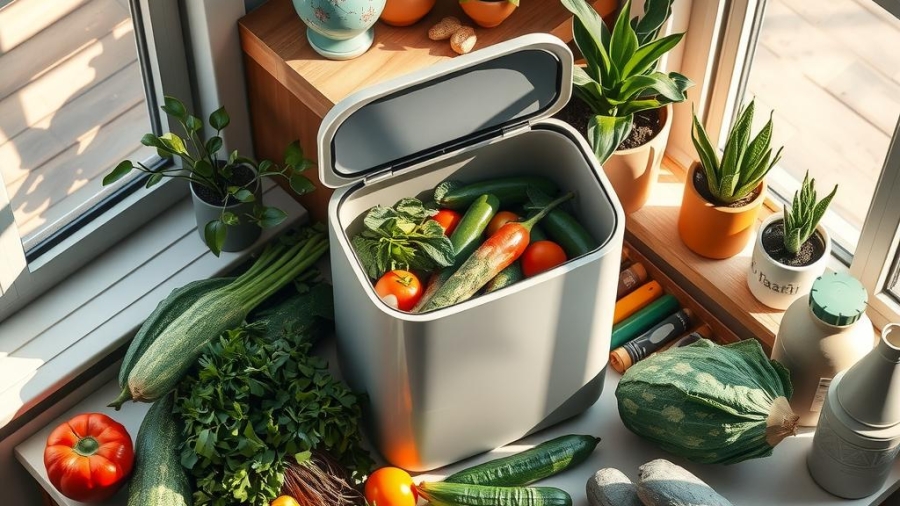In an urban landscape where space is often at a premium, the idea of composting can seem daunting, particularly for apartment dwellers. Many individuals are hesitant to embrace apartment composting due to concerns about unpleasant odors that could invade their living spaces. The common misconception that indoor composting leads to a smelly environment has deterred many from pursuing this eco-friendly solution, but it doesn’t have to be this way. This comprehensive guide aims to demystify the process of odor-free composting, equipping readers with practical strategies and tips for effective waste management in confined settings.
The core value of this article lies in its focus on sustainable living without compromising comfort. Apartment residents can enjoy the benefits of recycling kitchen scraps and yard waste while maintaining a fresh and pleasant home atmosphere. By understanding how smell control works within the realm of composting, anyone can transform organic waste into nutrient-rich soil amendments with minimal hassle or odor.
As urban populations continue to rise, finding innovative ways to manage waste becomes increasingly crucial. Composting offers a viable path toward reducing landfill contributions while fostering environmental stewardship right from one’s kitchen counter or balcony garden. Throughout this guide, readers will discover essential techniques tailored for small spaces—everything from selecting appropriate containers designed for indoor use to implementing natural additives that assist in minimizing unwanted scents.
Moreover, emphasis will be placed on choosing methods and products that support not just effective decomposition but also align with values centered around sustainability and eco-friendliness. For those seeking solutions compatible with busy lifestyles yet impactful enough to contribute positively toward ecological health, adopting these practices might just ignite new enthusiasm for green living.
With each section revealing further insights into successful apartment composting practices devoid of unpleasant aromas, readers will gain confidence as they navigate their own indoor gardening adventures. Embrace the opportunity; let’s dive deep into your ultimate composting guide, ensuring you’re equipped not only with knowledge but also practical tools necessary for creating an environmentally friendly oasis amidst city life—all without any lingering smells!

Key Points:
-
Understanding Smell Control Techniques: Effective strategies for maintaining a pleasant indoor environment during the composting process.
In urban settings, residents often express concern regarding odors that may arise from apartment composting. This guide highlights various techniques for achieving odor-free composting, such as proper layering of organic materials and incorporating carbon-rich ingredients. By utilizing these methods, individuals can transform kitchen waste into nutrient-rich soil while ensuring that their living spaces remain fresh and inviting. -
Innovative Tools for Indoor Composting: Specialized products designed to enhance the composting experience without compromising air quality.
The journey towards efficient indoor composting is greatly aided by modern tools tailored for small spaces. These innovative solutions include compact bins equipped with features that promote aeration and odor filtration, thus addressing common concerns about smell control. When selecting products, it’s essential to consider options like airtight containers or specialized filters that effectively minimize unpleasant aromas during the decomposition process. -
Sustainable Practices in Waste Management: Emphasizing eco-friendly solutions as integral components of daily life in apartments.
Engaging in sustainable living through composting guide practices not only reduces waste but also contributes positively to environmental health. By adopting effective strategies outlined in this resource, residents can turn everyday food scraps into valuable resources while fostering a culture of responsibility toward waste management. The integration of thoughtful practices ensures that even those new to gardening or sustainability can participate fully without fear of discomfort related to odors or hygiene issues associated with traditional compost systems.

Understanding Apartment Composting
The Essentials of Eco-Friendly Waste Management
Apartment composting is an innovative solution for urban dwellers keen on reducing their waste footprint while contributing positively to the environment. In small living spaces, traditional composting methods may seem impractical; however, understanding the fundamentals can make this eco-friendly practice accessible and effective. Indoor composting systems, such as worm bins or bokashi buckets, are designed specifically for limited spaces and provide a simple yet impactful way to manage kitchen scraps and organic waste. By diverting food waste from landfills where it would otherwise decompose anaerobically—producing methane gas—apartment residents can significantly lower their carbon footprint. This not only promotes sustainable living but also fosters a deeper connection with nature within urban environments.
Practical Steps for Successful Composting in Small Spaces
To embark on apartment composting successfully, one must first familiarize themselves with essential techniques that ensure odor-free operations and efficient breakdown of materials. A well-structured composting guide will typically recommend starting with a balanced mix of greens (nitrogen-rich materials like fruit peels) and browns (carbon-rich items like cardboard). Choosing an appropriate container is crucial; look for options that offer proper ventilation to aid decomposition without excess moisture accumulation leading to unpleasant smells—a common concern among beginners in smell control. Furthermore, maintaining the right conditions by monitoring temperature and moisture levels can enhance the efficiency of indoor compost systems, allowing residents to produce nutrient-rich soil amendments seamlessly.
Benefits Beyond Waste Reduction
The benefits of apartment composting extend beyond mere waste management; they encompass environmental education and community engagement as well. Engaging in this sustainable practice allows individuals to witness firsthand the transformation of organic matter into valuable resources while sharing insights with neighbors who may be interested in similar eco-friendly solutions. As more people adopt practices like these within communal living areas or apartment complexes, there arises an opportunity for collective initiatives aimed at promoting greener lifestyles throughout communities. Additionally, producing homemade fertilizer contributes not only to individual gardens but also supports biodiversity by enriching local ecosystems.
Overcoming Challenges: Tips for Efficient Indoor Composting
Despite its myriad advantages, some challenges may arise when initiating apartment composting practices that could deter potential enthusiasts. Common concerns include managing odors effectively or ensuring pests do not become problematic companions during decomposition processes. However, employing strategies such as regularly rotating contents within containers—akin to turning traditional outdoor piles—and using natural deodorizers like baking soda can mitigate these issues significantly. For those particularly anxious about attracting unwanted critters, selecting sealed bins designed explicitly for indoor use serves as another layer of protection against pests while enhancing ease-of-use functionality overall. Through awareness and careful planning around potential obstacles associated with indoor setups comes greater confidence toward embracing this transformative journey into eco-consciousness through apartment composting.
Odor Control Techniques
Effective Strategies for Smell-Free Indoor Composting
Indoor composting can be a rewarding endeavor, contributing to sustainable living and effective waste management. However, one of the primary concerns for those engaging in apartment composting is odor control. Properly managed, odor-free composting not only minimizes unpleasant smells but also maximizes decomposition efficiency, ensuring that organic waste transforms into valuable nutrient-rich soil without becoming a nuisance. To achieve this, it is essential to understand the factors that contribute to odors in compost and implement strategies that promote an eco-friendly solution.
A core principle of successful indoor composting lies in maintaining the right balance between carbon-rich “browns” (such as leaves and cardboard) and nitrogen-rich “greens” (like fruit scraps and vegetable peels). The ideal ratio typically hovers around 30:1 – for every part nitrogen material, three parts carbon are recommended. This balance fosters aerobic conditions within the compost pile or bin which helps prevent anaerobic bacteria from thriving; these bacteria are primarily responsible for foul-smelling odors. In addition to balancing materials, regular turning or mixing of the contents encourages proper aeration while speeding up decomposition processes.
Moisture levels play a critical role as well; too much moisture can lead to soggy conditions that favor odor-producing microorganisms. Conversely, overly dry conditions slow down decomposition significantly. It’s advisable for individuals practicing indoor composting to monitor humidity levels closely—keeping them within optimal ranges will enhance microbial activity without inviting undesirable smells.
Another innovative approach involves integrating natural additives known for their smell-control properties into the mix. For instance, utilizing activated charcoal or baking soda can help absorb excess odors effectively while maintaining a pleasant environment inside the home. Additionally, incorporating herbs such as mint or lavender not only introduces delightful scents but may also deter pests from invading your indoor ecosystem.
Furthermore, investing in appropriate containers designed specifically for indoor use can make a significant difference in managing odors effectively during apartment composting efforts. Airtight bins with filters allow gases produced during decomposition to escape while containing any potential leaks associated with liquid runoff—this design prevents messes commonly linked with traditional open-air methods.
Ultimately, embarking on an indoor composting guide equips individuals with knowledge about how best to manage organic waste sustainably without sacrificing comfort due to unwanted smells permeating their living spaces. By applying these techniques diligently—balancing materials correctly along with monitoring moisture levels—the journey towards effective waste management becomes far more enjoyable and achievable while promoting eco-friendliness at home.
Essential Tools and Products for Apartment Composting
Innovative Solutions for Odor-Free Indoor Composting
In the realm of apartment composting, the quest for effective waste management solutions that fit seamlessly into urban living is becoming increasingly vital. Many individuals are seeking innovative products that not only enhance their composting experience but also maintain freshness within their indoor spaces. One of the key aspects to consider when diving into this eco-friendly endeavor is odor control. The right tools can significantly reduce unpleasant smells often associated with organic waste, making it feasible to practice sustainable living even in small apartments.
For those interested in indoor composting, a variety of compact bins designed specifically for limited spaces have emerged on the market. These bins often feature advanced ventilation systems that promote aerobic decomposition while minimizing odors, allowing users to maintain a pleasant atmosphere in their homes. Some models incorporate charcoal filters or other odor-neutralizing technologies which effectively trap unwanted scents, ensuring that composting does not interfere with daily life.
Additionally, many modern composters come equipped with smart technology features, providing real-time feedback and guidance through apps or integrated displays. This functionality serves as an excellent resource for beginners navigating through a comprehensive composting guide—from understanding which materials are suitable for composting to monitoring moisture levels essential for successful breakdown processes. By leveraging these technological advancements, urban dwellers can feel empowered in their efforts toward sustainable waste management.
Furthermore, choosing appropriate additives or activators can greatly enhance the efficiency of apartment compost systems. Certain products designed specifically for home use help accelerate decomposition while maintaining optimal conditions within your composter. These eco-friendly solutions enrich your mix by introducing beneficial microorganisms essential in breaking down food scraps more rapidly without producing foul odors.
When considering options available today, it’s important to evaluate how each tool fits into one’s lifestyle and space constraints while ensuring they align with personal sustainability goals. Whether opting for stylish countertop units or discreet under-sink setups, there exists a solution tailored perfectly to every individual’s needs—demonstrating that effective smell control does not have to compromise aesthetic values.
The journey towards effective apartment composting involves selecting tools and products thoughtfully crafted to simplify the process without sacrificing quality or comfort at home. With countless resources readily available—from user-friendly containers equipped with smell-proof lids to engaging community forums sharing best practices—the shift towards greener habits has never been more accessible than now amidst rising urbanization trends.
Frequently Asked Questions:
Q: How can I start apartment composting without attracting odors?
A: Starting apartment composting while maintaining an odor-free environment is achievable with the right techniques. Utilizing specialized bins designed for indoor composting helps contain smells effectively. Additionally, layering carbon-rich materials like dried leaves or shredded paper with nitrogen-rich scraps such as fruit and vegetable peels aids in efficient decomposition and minimizes odors.
Q: What are some effective methods for smell control during indoor composting?
A: Effective smell control can be maintained through a combination of proper ventilation and regular mixing of the compost materials. Incorporating products that promote aeration, such as perforated bins or tumblers, encourages airflow and reduces the likelihood of unpleasant aromas developing. Regularly adding dry materials also absorbs excess moisture, further enhancing odor management.
Q: Are there specific products recommended in this comprehensive composting guide to improve my experience?
A: Yes, this comprehensive composting guide highlights various innovative tools tailored for small spaces that facilitate successful indoor composting. Look for compact countertop systems or worm bins specifically designed to handle kitchen waste efficiently while keeping odors at bay. These eco-friendly solutions not only streamline waste management but also contribute positively to sustainable living practices within urban environments.
